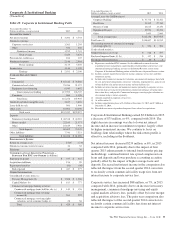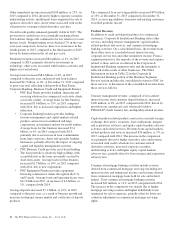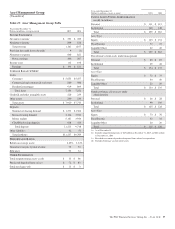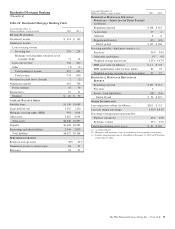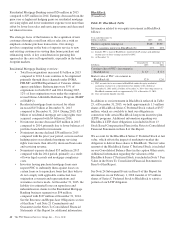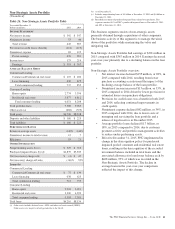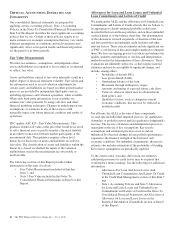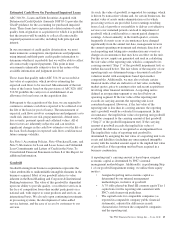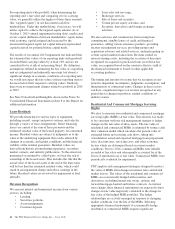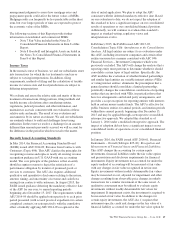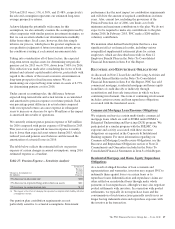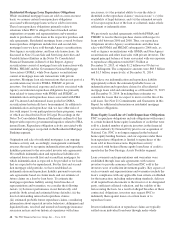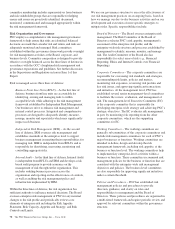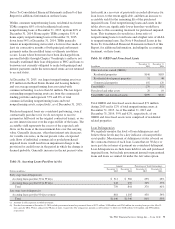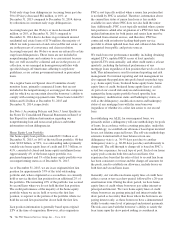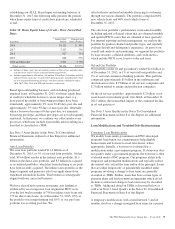PNC Bank 2015 Annual Report Download - page 83
Download and view the complete annual report
Please find page 83 of the 2015 PNC Bank annual report below. You can navigate through the pages in the report by either clicking on the pages listed below, or by using the keyword search tool below to find specific information within the annual report.
management judgment to assess how mortgage rates and
prepayment speeds could affect the future values of MSRs.
Hedging results can frequently be less predictable in the short
term, but over longer periods of time are expected to protect
the economic value of the MSRs.
The following sections of this Report provide further
information on residential and commercial MSRs:
• Note 7 Fair Value included in the Notes To
Consolidated Financial Statements in Item 8 of this
Report.
• Note 8 Goodwill and Intangible Assets included in
the Notes To Consolidated Financial Statements in
Item 8 of this Report.
Income Taxes
In the normal course of business, we and our subsidiaries enter
into transactions for which the tax treatment is unclear or
subject to varying interpretations. In addition, filing
requirements, methods of filing and the calculation of taxable
income in various state and local jurisdictions are subject to
differing interpretations.
We evaluate and assess the relative risks and merits of the tax
treatment of transactions, filing positions, filing methods and
taxable income calculations after considering statutes,
regulations, judicial precedent, and other information, and
maintain tax accruals consistent with our evaluation of these
relative risks and merits. The result of our evaluation and
assessment is by its nature an estimate. We and our subsidiaries
are routinely subject to audit and challenges from taxing
authorities. In the event we resolve a challenge for an amount
different than amounts previously accrued, we will account for
the difference in the period in which we resolve the matter.
Recently Issued Accounting Standards
In May 2014, the Financial Accounting Standard Board
(FASB) issued ASU 2014-09, Revenue from Contracts with
Customers (Topic 606). This ASU clarifies the principles for
recognizing revenue and replaces nearly all existing revenue
recognition guidance in U.S. GAAP with one accounting
model. The core principle of the guidance is that an entity
should recognize revenue to depict the satisfaction of a
performance obligation by transfer of promised goods or
services to customers. The ASU also requires additional
qualitative and quantitative disclosures relating to the nature,
amount, timing, and uncertainty of revenue and cash flows
arising from contracts with customers. In August 2015, the
FASB issued guidance deferring the mandatory effective date
of the ASU for one year, to annual reporting periods
beginning after December 15, 2017. The requirements within
ASU 2014-09 should be applied retrospectively to each prior
period presented (with several practical expedients for certain
completed contracts) or retrospectively with the cumulative
effect of initially applying ASU 2014-09 recognized at the
date of initial application. We plan to adopt the ASU
consistent with the deferred mandatory effective date. Based
on our evaluation to date, we do not expect the adoption of
this standard to have a significant impact on our consolidated
results of operations or our consolidated financial position.
Additionally, we will continue to evaluate this standard’s
impact as standard-setting, regulatory views and
interpretations evolve.
In February 2015, the FASB issued ASU 2015-02,
Consolidation (Topic 810): Amendments to the Consolidation
Analysis. All legal entities are subject to re-evaluation under
this ASU, including investment companies and certain other
entities measured in a manner consistent with ASC 946
Financial Services – Investment Companies which were
previously excluded. The ASU will change the analysis that a
reporting entity must perform to determine whether it should
consolidate certain types of legal entities. Specifically, the
ASU modifies the evaluation of whether limited partnerships
and similar legal entities are variable interest entities (VIEs)
or voting interest entities; eliminates the presumption that a
general partner should consolidate a limited partnership;
potentially changes the consolidation conclusions of reporting
entities that are involved with VIEs, in particular those that
have fee arrangements and related party arrangements, and
provides a scope exception for reporting entities with interests
held in certain money market funds. The ASU is effective for
public business entities for annual periods, and interim periods
within those annual periods, beginning after December 15,
2015 and may be applied through a retrospective or modified
retrospective approach. We adopted this standard as of
January 1, 2016 under a modified retrospective approach. The
impact of adoption did not have a significant impact on our
consolidated results of operations or our consolidated financial
position.
In January 2016, the FASB issued ASU 2016-01, Financial
Instruments – Overall (Subtopic 825-10): Recognition and
Measurement of Financial Assets and Financial Liabilities.
This ASU changes the accounting for certain equity
investments, financial liabilities under the fair value option
and presentation and disclosure requirements for financial
instruments. Equity investments not accounted for under the
equity method of accounting will be measured at fair value
with any changes in fair value recognized in net income.
Equity investments without readily determinable fair values
may be measured at cost, adjusted for impairment and other
changes resulting from observable price changes in orderly
transactions for a similar investment of the same issuer. A
qualitative assessment may be utilized to evaluate equity
investments without readily determinable fair values for
impairment. If impairment exists, the investment is required to
be measured at fair value. In addition to the changes for
certain equity investments, the ASU also 1) requires that
instrument-specific credit risk changes in the fair value of a
financial liability accounted for under the fair value option be
The PNC Financial Services Group, Inc. – Form 10-K 65


